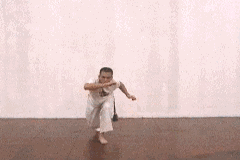| Queixada | |
|---|---|
 Queixada kick in capoeira game | |
| Name | Queixada |
| Meaning | jaw |
| AKA | meia lua virada |
| Type | kick |
| Parent style | capoeira carioca capoeira regional |
| Parent technique | meia lua de frente |
| Child technique(s) |
|
| Escapes | esquiva, negativa |
| Counters | rasteira |
Queixada (jaw or chin strike [1] ) is a crescent kick in capoeira, like the inverse of a meia lua de frente . [2]
Contents
- History
- Application
- Variations
- With the back leg kicking
- With the front leg kicking
- Literature
- References
- See also
This kick targets the side of the opponent's head or the opponent's chin (queixo in Portuguese). [2]
Queixada is one of the most common kicks in regional capoeira. Capoeira Angola players rarely use queixada. [3]
